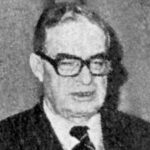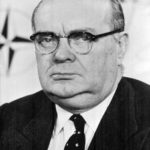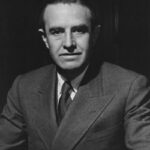Organisation for European Economic Cooperation (OEEC)
- Date of Founding
- Date of Abolition
- Location
The Organisation for European Economic Cooperation (OEEC) was created on 16 April 1948, as the result of the deliberations between the sixteen nations that took part in the Committee for European Economic Cooperation (CEEC) in Paris over the summer of 1947, and as a result of the signing of the Economic Cooperation Act by U.S. Congress. The creation of a European organization to deal with the administration of Marshall Aid, as well as their common economic problems, was a precondition from the U.S. government for the granting of Marshall Aid.
It also placed the responsibility for the success of the European Recovery Program (ERP) on the Europeans themselves, by stressing that they themselves needed to take the initiatives and bring the sacrifices that were needed in order to institutionalize economic cooperation between the sixteen participating countries. The countries that participating in the OEEC were: Austria, Belgium, Denmark, France, Greece, Iceland, Ireland, Italy, Luxembourg, Netherlands, Norway, Portugal, Sweden, Switzerland, Turkey, United Kingdom, and Western Germany (originally represented by both the combined American and British occupation zones (The Bizone) and the French occupation zone). The Anglo-American zone of the Free Territory of Trieste was also a participant in the OEEC until it returned to Italian sovereignty.
The goal of the OEEC was to promote economic co-operation between participating countries, to coordinate between their national production programs, to develop intra-European trade by reducing tariffs and trade barriers, to study the feasibility of creating a customs union or free trade area, and to study the multilateralization of intra-European payments.
From the beginning, the OEEC had an elaborate intergovernmental institutional set-up, so that decision-making rested on the consent of member states. The British who had favored a weak organization (opposed to a strong organization) had agreed to create the post of a Secretary-General for the organization (which was a wish from the French), but they had not given it any decision-making powers. The post of Secretary-General, as such, was initially set-up as a purely administrative post. Eventually, however, the civil servants in the OEEC, with the support of the members states who wanted more political authority invested in the OEEC, managed to carve out some leeway in creating a Consultative Group of Ministers and even the created post of Political Conciliator in 1950.
Housed at the impressive Chateau de la Muette in Paris, the OEEC consisted of many technical subcommittees (so-called vertical committees). For example, manpower, programs, electricity, coal, oil, etc. Other committees (so-called horizontal committees) had a broader scope, such as intra-European trade, or intra-European payments. These issues touched the way in which economic relations were governed.
Decision-making went through the Council of the OEEC, where representatives of the members states had a seat, and was based on unanimity. This strict rule of unanimity sometimes impinged on the progress of the work of the organization, and creative ways for decision making had to be found (for example by creating study groups, or groups of wise men).
Recurring issues for the OEEC during the Marshall Plan years (1948-1952) were the yearly appropriations of Marshall Aid, as well as the broader questions of how to close the dollar gap (the balance of payments deficit with the dollar zone). The Europeans hoped to tackle this last problem by increasing their exports and thus their dollar-earning capacities. In doing this, they needed to increase their production and productivity which became a key goal of the OEEC-members national programs for reconstruction. Another means to close the dollar-gap was by increasing intra-European trade (especially with Germany), thereby reducing the need to import goods from the Americans. The preferred route of increasing intra-European trade was by monetary means. Between 1947 and 1950, the OEEC-members created a series of intra-European Payments Schemes, and eventually this culminated in the creation of the European Payments Union (EPU) in 1950.
In 1961, the OEEC was transformed into the Organisation for Economic Cooperation and Development (OECD), and it shook of its purely European-oriented nature of economic cooperation which was deepening and continuing in the European Economic Community (EEC) and the European Free Trade Agreement (EFTA) or the European of the six and the seven.






